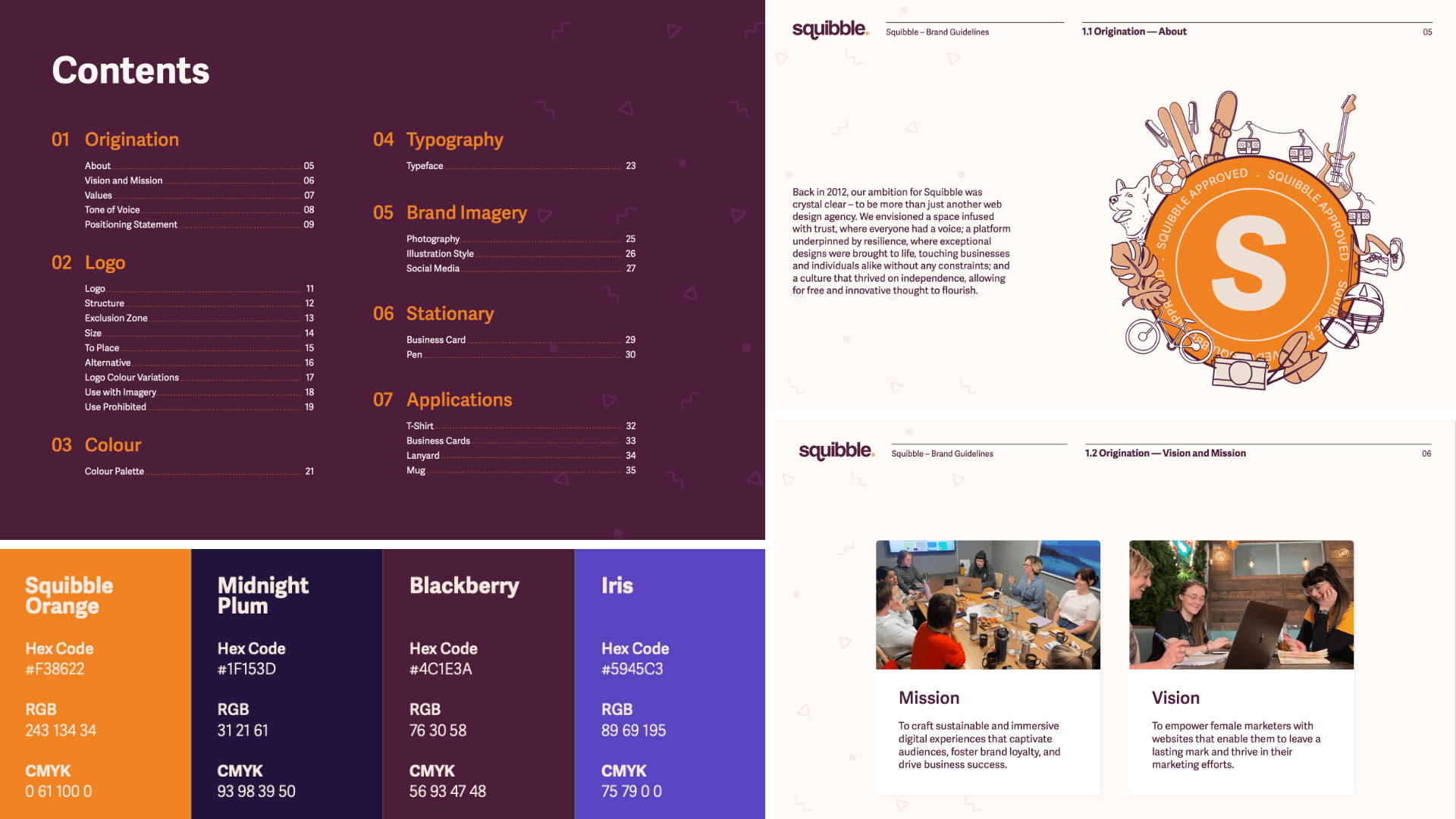What Is The Purpose of Rebranding?
Rebranding a business isn’t just about aesthetics; it’s a strategic decision driven by various critical needs. Firstly, a company may rebrand to update an outdated brand identity, ensuring its image reflects modern values and technologies. Secondly, as a business evolves, its original messaging may no longer align with its current objectives or operations, necessitating a rebrand to ensure consistency in communication. Lastly, significant organisational changes like restructuring or expanding into new markets often require a rebrand to unify the expanded entity under a single, cohesive identity. These are just a few reasons why businesses might undertake a rebranding effort.
What is rebranding?
Rebranding is a comprehensive transformation that refreshes a brand’s identity and strategic direction. It involves not just tweaking the visual elements like logos and colour schemes, but also redefining the brand’s story, marketing materials, and overall strategy to align with current goals and market demands.
Rebranding includes several key actions:
- Visual Identity Redesign: This means updating the look of the brand, including changes to the logo, the type of fonts used, and the general style to make it more current.
- Strategic Repositioning: This involves changing the brand’s focus to appeal to new groups of customers or to better match the company’s evolving goals.
- Cultural Alignment: It’s about adjusting the brand so that it fits well with today’s societal values and norms.
- Digital Transformation: Revamping the brand’s digital spaces, like websites and apps, to enhance how users interact with them and to incorporate the latest technology.
Together, these elements work to maintain a brand’s relevance, competitiveness, and connection with its audience as markets and consumer behaviors change over time.
Rebranding is essential to keep a brand relevant and effective in connecting with its audience. As markets evolve and consumer preferences change, a brand’s messaging and appearance might become outdated or misaligned. Rebranding updates these elements to keep the brand competitive. Additionally, it helps businesses expand into new markets, recover from negative publicity, and stay current with technological advances. This strategic update is crucial for transforming the brand from its current state to its desired future state, ensuring it resonates well with its target audience.
The Benefits of Rebranding
Rebranding is more than just a trend; it’s a strategic move that revitalises your brand. It refreshes your brand’s identity, strengthens connections with your customers, and helps clear away any outdated perceptions. This process boosts your image and visibility, ensuring your brand stays relevant and competitive in a constantly changing market.
Additional benefits include:
- Increased Clarity: Makes your brand’s purpose clearer to customers.
- Employee Morale: Boosts staff morale and aligns them with the brand’s mission.
- Adaptation to Market Changes: Allows your brand to adapt to new consumer trends and competitive challenges.
Attract More and Better Customers
Attracting customers effectively is crucial for any business. To do this, companies need to have a strong online presence that isn’t just functional but is also engaging and easy to navigate. A good website and active social media can draw people in, but the real magic happens when the products and services consistently exceed expectations. Statistics show that companies with strong digital marketing strategies see up to a 2.8 times higher revenue growth expectancy. This is why investing in quality online content and interactive platforms can significantly boost customer attraction and retention.
Stand Out from the Competition
In a competitive market, it’s essential not just to blend in but to stand out. To thrive, businesses must develop unique selling propositions that distinguish them from others. Whether it’s through innovative products, exceptional customer service, or unique marketing campaigns, being distinctive is key. For example, brands that are perceived as conducting business responsibly attract 92% more customer trust than those that don’t. Therefore, integrating ethical practices and transparency into the brand strategy can not only differentiate a business but also build lasting customer loyalty.
Attract Top Talent
Attracting top talent goes beyond offering competitive salaries. Creating a work environment that values work-life balance, flexibility, and ongoing professional development is crucial. For instance, companies that promote remote work have seen a 25% lower employee turnover rate. Furthermore, businesses investing in employee growth and development are 15% more likely to attract top talent. By fostering an inclusive and supportive culture, companies can attract professionals who are not only skilled but also highly motivated and loyal.
Close More Sales & Leads
Closing sales is like an art form that requires not only initial contact but also ongoing engagement and trust-building. Salespeople who actively engage with their prospects through informed and confident communication are more likely to succeed. Studies suggest that a well-strategised customer relationship management system can increase sales by up to 29%. By being proactive and responsive, businesses can convert inquiries into sales more effectively and build relationships that encourage repeat business.
Command Premium Prices
To command premium prices, businesses must exceed customer expectations consistently. This involves understanding and delivering on customer needs at a level that distinguishes the brand from competitors. Brands that are perceived as high-quality can price their products up to 20% higher than the market average and still drive customer loyalty. Effective strategies include exceptional product quality, standout customer service, and a brand reputation that communicates unparalleled value.
By focusing on these aspects, businesses can effectively rebrand and position themselves for long-term success in a competitive landscape.
Why do companies choose to rebrand?
The reasons are as diverse as the companies themselves, and each rebranding effort is tailored specifically to the company’s unique needs. Rebranding can be proactive, driven by a desire to capitalise on new growth opportunities, embrace innovation, or reforge a connection with the audience. It can also be reactive, such as in response to mergers, product discontinuations, or to recover from bad press.
Rebranding might also be necessary when technological advancements change the way we do business, when expanding internationally to appeal to new markets with different cultural expectations, or due to legal reasons like trademark disputes.
When should a company consider rebranding?
A company should consider rebranding when significant shifts occur, such as mergers or when their current brand messaging no longer aligns with their vision or resonates with their target market. It’s not a decision made on a whim but a strategic response to evolving business landscapes or new opportunities.

Preparing Your Marketing Toolbox
It’s time to explore what goes into a robust marketing toolbox to help you achieve your business goals, whether that’s attracting new clients, generating leads, or giving your brand a professional boost. Key components include:
- Company Logo: Your logo acts as the face of your company. It’s a powerful symbol that communicates your identity and values to the world.
- Business Cards: These small but mighty tools are crucial for making lasting impressions and maintaining connections after initial meetings.
- Business Website: Consider your website as your online headquarters. Here, it’s vital to ensure smooth functionality and engaging content to keep visitors interested and converting into customers.
- Illustrations: Using visuals can transform how you communicate complex information, making it more digestible and appealing to your audience.
- Promotional Material: This is your chance to get creative with materials that highlight new products or services, designed to captivate and attract potential customers.
- Style Guide: A style guide is essential for maintaining brand consistency across all materials. It ensures that regardless of the platform or medium, your brand’s voice remains uniform, reinforcing brand recognition.
Each element of your marketing collateral should be thoughtfully designed and aligned with your overall brand strategy to ensure cohesion and maximise impact.
Not got a Marketing Toolbox? We can help you start to build one today. Contact us.
What to think about when rebranding?
When thinking about rebranding, it’s crucial not to start from scratch. Effective rebranding builds on the existing strengths and loyalty that your brand has already established. Consider what has changed in your market since your last update. Use these insights to adjust your brand’s image and messaging—whether through small tweaks or major changes. The goal is to enhance how you connect with customers, making sure that every change aligns with your broader business objectives.
Here’s a quick checklist to consider when planning a rebranding:
- Assess Current Brand: Understand what elements of the current brand are working well and what aren’t.
- Market Research: Study market trends, competitor positioning, and customer feedback.
- Define Brand Vision: Clearly articulate the goals and vision for the rebrand.
- Customer Loyalty: Evaluate how to retain current customers while attracting new ones.
- Visual Identity: Plan updates to logos, colors, and overall design.
- Brand Messaging: Refine the voice and messaging to better align with the new brand identity.
- Digital Presence: Overhaul the website, social media, and other digital platforms.
- Internal Alignment: Ensure all team members understand and support the rebrand.
- Launch Strategy: Develop a plan for rolling out the new brand to the public.
- Monitor Feedback: After launch, gather feedback and be prepared to make adjustments.
These steps can help guide your rebranding efforts to ensure a smooth and successful transition.
What makes a successful rebrand?
Rebranding blends art and strategy, balancing the old and the new. It involves significant changes that not only attract new customers but also keep current ones engaged. The changes made should stay true to the company’s fundamental values to avoid losing the brand’s identity. The rollout should be coordinated across all parts of the company to ensure everyone is aligned. Rebranding is more than just updating the look—it’s about evolving the brand while staying true to its core values.
What is the average cost of a rebrand?
In the UK, the cost of rebranding for small and medium-sized enterprises (SMEs) varies significantly based on the scope and scale of the project. A basic branding project can start from £1,000 to £5,000, which typically includes simpler tasks like logo redesign and basic marketing materials. However, for a full rebrand, SMEs might spend anywhere from £5,000 to £50,000 or more, depending on the depth of the rebrand which might include comprehensive changes to all branding elements, marketing strategy, and even a complete overhaul of the brand’s visual identity and messaging strategies.
This cost can encompass a variety of services, including brand audits, developing new brand guidelines, market research, updating or creating new digital assets like websites, and extensive internal and customer research to align the brand’s identity with its current market position and future goals.

Why are brand guidelines key to a successful rebrand?
Most business owners don’t want to invest in brand guidelines, but this is a big mistake. Brand guidelines are vital for maintaining a cohesive brand identity across all marketing efforts and customer interactions. Without them, the brand can appear inconsistent and unprofessional, which can weaken customer trust and overall perception of the brand. Investing in comprehensive brand guidelines is crucial for maintaining a strong and recognisable brand identity. These guidelines provide clear instructions to everyone involved in content creation, from designers to marketers, ensuring that all materials consistently reflect the brand’s values and aesthetics. This not only saves time and resources but also helps avoid inconsistencies that can dilute the brand’s impact. As the brand evolves and adapts over time, having solid brand guidelines helps maintain its core identity, making it more recognisable and reliable in the eyes of customers.
Brand guidelines are key to a successful rebrand as they ensure uniformity across all aspects of a brand’s representation. Serving as a detailed manual, they dictate how the brand’s identity—including logos, color schemes, typography, and communication tone—should be conveyed across various platforms. This consistency is vital for strengthening the brand’s identity and ensuring it resonates effectively with both potential and existing customers.
When a company undergoes a rebrand, these guidelines help maintain uniformity in how the brand is presented in different media and platforms, whether in digital marketing, physical packaging, or customer service interactions. This uniform appearance and messaging reinforce the brand’s new identity and help to build trust and loyalty among both existing and new customers. Without such guidelines, a brand’s message could become disjointed, potentially confusing customers and diluting the brand’s impact.
FAQs
What is the purpose of rebranding? Rebranding is a strategic renewal process aimed at improving a company’s image in response to its evolving goals, market demands, or internal changes. It often includes updating the brand name, logo, and design elements to create a fresh identity. This new identity helps realign the brand’s image with current business objectives, ensuring that it resonates better with current and potential customers, investors, and the broader market. It’s a way for businesses to signal changes in direction, commitment to innovation, or improvements in services or products.
Why do companies rebrand? Companies undertake rebranding to revitalise their image, connect with new demographics, adapt to market changes, overcome negative perceptions, or articulate changes in their company values or mission. This strategic decision is driven by the need to remain competitive and relevant in a fast-paced market environment. Rebranding allows a company to shed outdated images and perceptions, engage with new audiences, and better reflect its current offerings and future direction. It’s also a response to external pressures like competitive threats, changing customer preferences, or shifts in the industry landscape.
How does rebranding work? Rebranding involves a systematic approach starting with a thorough analysis of the existing brand to identify its strengths and weaknesses. This phase helps in understanding what elements need to be refreshed or overhauled. The next steps include designing a new brand identity—such as logos, color schemes, and overall design language—and creating a strategic plan for implementing the new branding across all company assets and communications. This might involve updating marketing materials, changing the signage, revamping the website, and conducting a comprehensive communication strategy to introduce the new brand to the public and stakeholders.
What are the benefits of rebranding? Rebranding can rejuvenate a company’s image, attract new customers, and increase market competitiveness. The primary benefits include renewed interest from the public and existing customers, improved positioning within the market, and often, an uptick in sales and customer engagement. A successful rebrand can also lead to enhanced brand equity, a clearer representation of the company’s values and objectives, and an updated, more relevant image that resonates with a broader audience.
What are the risks of rebranding? While rebranding can offer significant rewards, it also comes with risks. If not managed carefully, it can confuse customers, alienate loyal followers, and result in negative publicity. The new brand identity might not resonate with the existing customer base, leading to a disconnect between the company’s intended market position and public perception. Missteps in the rebranding process, such as a lack of coherence between the new brand elements and the company’s values, can dilute the brand’s identity and weaken its market position.
How much does rebranding cost? The cost of rebranding can vary widely depending on the scope and scale of the project. For small to medium enterprises, costs can range from £2,000 to £5,000 for basic updates to more than £50,000 for comprehensive changes involving all aspects of the brand. The investment typically covers design services, market research, implementing the new brand across all platforms, and marketing the rebranded business. It’s important for companies to budget adequately and plan for both the immediate costs and ongoing expenses related to maintaining the new brand.
How should a company go about rebranding? A company should start rebranding by conducting extensive market research to understand current brand perceptions and identify market and industry trends. Engaging stakeholders in the rebranding process is crucial to ensure that the refreshed brand aligns with both internal expectations and customer needs. Working with experienced branding professionals can help in effectively navigating the rebranding process, from conceptual design to rolling out the new brand identity. Developing a detailed plan for launching and marketing the new brand is essential for ensuring a smooth transition and achieving the desired impact in the market.
What should be considered when rebranding? When rebranding, it’s important to consider factors such as the current strength of the brand equity, how well the existing brand is recognised, how market trends might influence the rebrand, stakeholder opinions, and the overall budget. Companies must also think about the potential impact on current customers and how to communicate the changes effectively without causing confusion or alienation.
What are the dangers of rebranding? The dangers of rebranding include losing touch with the core customer base, diluting brand equity, and encountering negative feedback which can result in a public relations issue. Misalignments between the new brand message and company values can lead to confusion both internally and externally.
What are the mistakes companies make when rebranding? Common mistakes in rebranding include insufficient market research, poor planning, underestimating the resources required, failing to fully commit to the new direction, and not engaging sufficiently with stakeholders. Companies often make the mistake of not communicating effectively with their audience before, during, and after the rebranding process, which can lead to issues such as customer confusion or backlash.
Rebranding Workshops at Our Birmingham HQ
Seeking a tailored rebranding experience? Our Birmingham HQ is adept at curating workshops catered to your specific needs. Dive into interactive sessions with our branding maestros to sculpt an identity that embodies your company’s spirit and aspirations.







